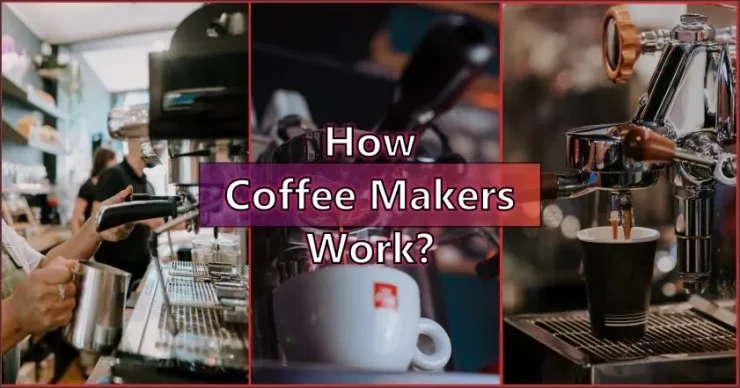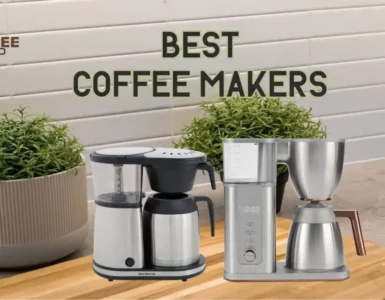Today, most homes have a coffee machine. Many people who drink coffee don’t have time for complicated ways to make it. With a coffee machine, all you have to do to get a cup of coffee is push a button.
Most coffee makers work by moving water through the ground coffee and into your cup. There are different parts of each kind of coffee machine. We’ll look at how coffee makers work.
How Do Single-Serve Coffee Machines Work?
Single-cup coffee makers, also called pod coffee makers, aren’t ideal if you can brew multiple cups of coffee for a large group at once.
In pod machines, capsules with coffee grounds are used. People frequently refer to K-Cups, Nespresso pods, or other similar containers that may be put straight into the engine to produce a fresh cup of coffee when they use the term “coffee pods.”
Before using, you’ll need to fill the water tank at the back of most pod coffee makers. If you reside in a region where the water is particularly hard, you may want to invest in a water filter.
The coffee maker draws water from the reservoir and passes it over a heating element. When you insert a coffee pod into the machine, the hot water will shoot up through the capsule, eventually draining into the cup below.
However, it’s estimated that over 56 billion single-serve pods and other coffee capsules end up in landfills yearly rather than being disposed of.
It would be better to recycle them. Because of this, the environmental impact of utilizing this sort of coffee machine would be reduced.
How Does an Automatic Drip Coffee Maker Work?
The process of making beer is similar to how manual overflow methods work. The machine does most of the work. After adding clean water to the reservoir, the coffee can be ground, and the brewing process can begin.
If you want the same amount of coffee, no matter how much water you use, you should increase the grind size as you grind and brew more coffee.
The grounds should be ground for less than half a liter of coffee until they are about as fine as sand. A salt with a medium-coarse grain should be used to produce more than one liter of coffee using a filter coffee maker.
Drip coffee makers utilize the entire water tank for brewing. Thus, slow overflows might cause water to bypass the coffee dripper entirely.
There are 6 g of coffee for every 100 ml of water, which is the same as for other gravity techniques. Coffee is “on the grinder,” so while you wait, it’s a good idea to run warm tap water through the paper filter.
When you’re ready to make coffee, discard the water and add the grounds. The Specialty Coffee Association (SCA) says the machine should use water between 92°C and 96°C when making coffee.
At the beginning of the brewing process, when the machine pours the first few drops of water on top of the ground coffee. You should stir the coffee with a spoon or a stirrer. All that’s left to do is wait for the coffee to finish, which should take 4-6 minutes.
After the coffee has been brewed, stir the jug to ensure the flavor is consistent. The strongest infusion of coffee is brewed first, while the weakest is brewed last.
How Do Espresso Machines Work?
Like pod machines, espresso machines need a water reservoir. Espresso machines use a water tank instead of the main water supply typically connected to professional espresso machines for home usage.
It is recommended that filtered water be utilized in all coffee makers because it improves flavor and decreases the accumulation of calcium in the pipes.
Espresso machines can make very strong shots of coffee but require a strong pump to force the reservoir’s water through the coffee grounds.
If you seek hard enough, you may find espresso machines with pumps that can handle pressures of up to fifteen bars. To make coffee, you need hot water and the ability to force it through the ground beans. Therefore, a boiler is also required.
Some espresso machines have one boiler to heat water, while others have two to heat water and milk. Another fancier choice is to boil the water and store it so it can be utilized whenever you wish to create another beverage.
Water temperature control is a feature that may or may not be available on your espresso machine. More affordable devices don’t always let you regulate the water temperature, but more expensive versions do.
Espresso makers with two boilers can use water at two different temperatures. Hot water from one boiler is passed through ground coffee for espresso-making.
They create steam in a separate boiler, sending it down a steam wand froth milk. As the water drips through a portafilter, heated by boilers, coffee is made.
How Do Coffee Bean-to-Cup Machines Operate?
Bean-to-cup coffee makers, sometimes called automatic coffee machines, work the same way as espresso machines. Hot water is pressed through a thin layer of ground coffee to prepare a quick and potent espresso.
The machine takes care of everything, from grinding the beans to compressing them into a puck and adding the correct amount of water. Consequently, with just one or two taps, you can always have a perfectly brewed cup of coffee.
Bean-to-cup coffee makers come in two varieties: those that require you to steam water manually and can automatically froth milk and add it to your coffee for a barista-quality beverage with no effort.
The machines that do everything for you, including changing the texture of the milk, usually have a menu screen where you can choose the type of coffee you want. You can choose from popular coffee shop drinks like espresso, cappuccino, latte, and flat white.
Fill the integrated carafe with milk so the device can texturize it and deliver just the right amount based on the coffee you choose. A removable milk carafe makes it easy to store in the refrigerator between cups of coffee, saving you from the agony of drinking milk that has gone bad.
A manual steam wand-equipped machine lets you choose the coffee base you want, such as a single or double espresso or ristretto, then dispense it into a cup.
The next step is to pour the desired amount of milk (or non-dairy substitute) into a jug, whisk it, and then pour it into the cup with the coffee.
How do Filter Coffee Makers Function?
Filter coffee makers, also called drip coffee makers, have a water reservoir, a basket for ground coffee, and a carafe for made coffee. The coffee maker, like any other appliance, needs water to function.
Hot water is fed into the filter basket after being heated by a coil heating element. The coffee grounds sit on a filter while hot water slowly trickles down onto them from above, eventually draining into a carafe below.
The carafe rests on a hot plate heated by the same burner to maintain a steady serving temperature when brewing is complete.
How Do French Press Coffee Makers Work?
Because they are hand-cranked, French press coffee makers are easy to use. French press coffee makers use a plunger with a filter that wraps completely around the carafe. After a brief steeping period, the grounds are extracted from the brew by applying pressure to the filter.
Tips for Using Coffee Makers
Not every cup of drip coffee has the same taste. You can always make your drip coffee taste great if you do certain things. In this article, we’ll examine some of the most effective methods for enhancing the taste of drip coffee.
Pay Attention to the Grind
You should never use ground coffee. That is too fine. For espresso machines, it’s better to use a fine grind. The coffee produced by a drip coffee maker using a fine grind is typically bitter. The coffee should be ground in the middle with a drip coffee maker.
This worry goes away when you buy ground coffee because the grind is often already set up for drip brewing. But if you want better coffee, you should purchase whole beans and grind them to a medium grind for the best flavor.
How Much You Brew
How much coffee you make is also important. Brewing less than a full carafe of coffee is a bad idea, but half a carafe is the bare minimum. A weaker cup of coffee results from brewing less than half a pot because the coffee rushes through the filter too quickly.
How Much Grounds to Use
This is one of the trickier parts of a drip coffee maker, especially if you have never used one before.
f you fill the carafe with coffee according to the conventional instructions, which call for 2 TBSPs per carafe number, you will have too much coffee. A coffee scoop is a handy tool for getting the perfect number of grinds into your coffee machine.
Freshly Ground Coffee is the Best
The ground coffee you can purchase at the store is designed for drip coffee makers, as was already mentioned. However, freshly ground coffee beans have no equal in terms of flavor.
As the coffee beans are ground, the aromatic oils and gases that give coffee its flavor are released, creating a cup with extra flavor. However, these aromas and flavors dissipate rapidly, which is why pre-ground coffee is a missed opportunity.
FAQs
How does a coffee maker’s pump work?
A vibratory pump, sometimes known as a vibe pump, is an efficient and compact electromagnetic motor. A metal coil holds a piston with a magnet attached to it. An electrical current flow through the loop to drive the piston back and forth and push water through the machine.
How much coffee should you put in the water?
The ratio of coffee to water used in a drip coffee machine should be 1:17.
How is the water heated in a coffee maker?
The heating element is on the left side of the coffeemaker’s base. The aluminum extrusion that makes up this component has a water pipe on one side and a resistive heating element on the other. The water is heated using a resistive heating element enclosed in an aluminum tube.
What distinguishes a drip coffee maker from a coffee percolator?
In a coffee percolator, the water is in the same place as the coffee. As the coffee brewing, the water goes through the filter basket and coffee grounds. This makes sure that the water stays hot and well-soaked. There is a water tank in a drip coffee maker. When the coffee is made brewing, it drips into a carafe.
Is the taste of decaf coffee different?
To most people, decaf coffee won’t taste any different from regular coffee, but some people with particularly sensitive palates may detect a difference.
What do you do with a coffee maker that doesn’t have a filter?
You can still make coffee even if you’re out of coffee filters. In place of a filter, you can use a paper towel, a strainer, or a rag in the kitchen. Alternative methods of brewing are possible, such as the use of instant or concentrated coffee.
Does it matter what kind of coffee machine you use?
Coffee is coffee, regardless of the brewer, but you’d be wrong to assume that. The brew you get from your coffee can vary depending on your coffee maker.
Do coffee makers that cost more make better coffee?
Most cheap coffee makers don’t get nearly that hot and burn out over time. The ground coffee is spread out more evenly when the brew head is bigger. This makes it easier to get the flavor out, which makes the taste better.
Conclusion
Many people would be lost without these helpful tips on how coffee makers work. The first thing you might do when you wake up is looking for your coffee machine so you can make a good cup of coffee. Without that caffeine boost, it’s just not the same.
You may not give your coffee machine much thought, but it is rather ingenious to transform the water into a steaming cup of joe. You can appreciate them much more now that you understand how coffee makers work.


















Add comment